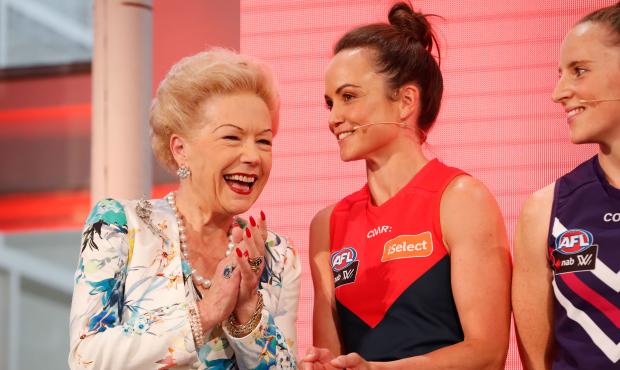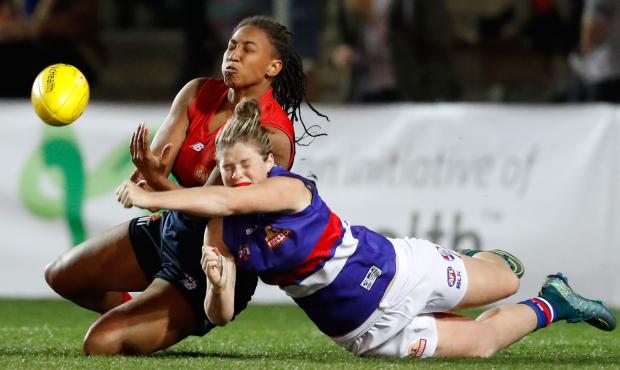IN 2010, the AFL commissioned a review into women’s football. While this was primarily focused on grassroots, junior and state levels, one of the suggestions made was for a national women’s competition.
At the time, 80,000 females played footy around the country and a rough starting date for the competition was put at 2020.
An exhibition match between Melbourne and the Western Bulldogs was played in June 2013, the first time women had represented AFL clubs.
A draft was held between the two clubs before the match, with Daisy Pearce taken first by the Demons and Stephanie Chiocci selected by the Bulldogs with the second pick.
Fast five: AFLW captains give their predictions
Subsequent exhibition matches between the clubs followed in 2014 and 2015. The second of two matches in 2015 was broadcast on free-to-air television and attracted higher ratings than the AFL match between Adelaide and Essendon the night before.
The reaction was swift. The AFL announced it was bringing forward the national competition’s starting date to 2017.
A series of exhibition matches was planned around the country for the 2016 season, culminating in an All-Stars match in September. Thousands filled Whitten Oval, and hundreds of thousands watched on television, as the best players from around the country put on a show. And by the end of 2016, more than 380,000 females were playing footy.
Details of the new competition were announced throughout 2016. All AFL clubs were invited to put in an application for a team, with 13 taking up the offer.
On June 15, the new league was officially launched at the MCG – still nameless and sponsorless – and the clubs who had been successfully awarded a licence were announced – Adelaide, the Brisbane Lions, Carlton, Collingwood, Fremantle, Greater Western Sydney, Melbourne and the Western Bulldogs.
The new clubs were given an opportunity to sign two marquee players, who will be paid more than their teammates for promotional work with their clubs and the AFL.
Clubs were also allowed to sign priority players, the number of which was determined by the AFL. The Giants were awarded five (one to cover for their injured marquee player Renee Forth); Adelaide, the Brisbane Lions and Fremantle two each (the Dockers were also granted an extra priority player to cover for injured marquee player Kiara Bowers); and Carlton, Collingwood, Melbourne and the Bulldogs one apiece.
Some priority players had pre-existing working relationships with clubs and were signed to recognise that.
Each club also signed two rookies, who had not been aligned with any football club for the previous three years or were new to the sport.
Many rookies have crossed from other sports, including Erin Phillips (Adelaide, basketball), Delissa Kimmince (Brisbane, cricket) and Kim Mickle (Fremantle, javelin).
The competition was officially as the NAB AFL Women’s competition in October.
Susan Alberti and Daisy Pearce have been pioneers of the women's game. Picture: AFL Photos
Then came draft day. A total of 145 players found their way on to AFL lists, with the order set by lottery.
GWS held pick one and selected Nicola Barr, before the clubs followed in a snake pattern – Melbourne had the last pick of round one, but the first of round two.
After the draft clubs could sign a further three free agents, taking their lists to 27, 28 or 29 depending on the number of priority picks awarded and long-term injuries.
Training started in late November and the draw was announced in December. The clubs will play each other once, leading to a seven-week season played around the country.
The top two will face off in the Grand Final on Saturday, March 25, at a yet-to-be-determined venue, coinciding with round one of the AFL season.
Adelaide has aligned with the Northern Territory, with Bec Goddard assigned the difficult task of working with a team based in Adelaide and Darwin. Senior assistant Andrew Hodges heads up the NT contingent.
The Brisbane Lions will represent Queensland, with former Collingwood player Craig Starcevich as coach. He was the high-performance manager for the men’s team during its triple-premiership era.
Damien Keeping will coach Carlton, having an impressive resume in women’s football. He has been an assistant coach in the VWFL Academy and for the Vic Metro youth girls team.
Collingwood has taken the unusual step of appointing a playing-football operations manager, with Meg Hutchins taking on the difficult role. Vic Metro youth girls coach Wayne Siekman is leading the Magpies.
Fremantle won the hotly contested race for the signature of the highly regarded Michelle Cowan, who spent the past two years working under Paul Roos at Melbourne as a development coach.
Greater Western Sydney will be led by former Sydney Swan Tim Schmidt. He has excellent knowledge of the local talent, having helped launch female academies around the state.
The Women's All-Star match in 2016 was a huge success. Picture: AFL Photos
Melbourne was an obvious choice for a licence, having spearheaded the development of elite women’s footy. Michael Stinear, a two-time premiership coach with the Oakleigh Chargers in the TAC Cup, will take the reins.
The Western Bulldogs, Melbourne’s pioneering partner, were also granted a licence. Paul Groves, former coach of VAFA team Monash Blues, coached them in the most recent exhibition match and will lead again in 2017.
Aggressive midfielder Courtney Cramey has captained South Australia since 2011 and is regarded as one of the best players in the state. Ebony Marinoff was the Crows’ first draft pick, and the former surf lifesaver has good endurance and a strong left foot.
Tayla Harris (Brisbane Lions) is a star in the making and will thrive on the national stage. She has one of the longest kicks in the game and loves getting up in the air and taking big marks. The marquee signing is also athletic at ground level.
Carlton signed contrasting pair Brianna Davey and Darcy Vescio as marquee players. Davey is a strong full-back and a former goalkeeper for the Matildas, whereas Vescio is a sharp forward who is always in the right spot. Former netballer and inside midfielder Sarah Hosking won the 2016 VFL Women’s rising star award.
AFLW awards revealed ... but titles on hold
Collingwood’s Moana Hope kicked more than 100 goals in the 2016 VFL Women’s competition and will have an A-grade midfield delivering her the ball. Jasmine Garner is regarded as one of the best marks in the game, the forward slipping to 86 in the draft with fitness queries, but she has put in a strong pre-season.
Fremantle drafted Hayley Miller at pick four after the young midfielder improved rapidly in the past two years. She’s a hard runner who kicked two goals with a fractured fibula in the Western Derby exhibition match. Marquee midfielder Kara Donnellan is a premiership-winning captain with Swan Districts.
The Giants’ No. 1 draft pick Nicola Barr is one of the best midfielders going around. She has the lethal combination of speed and endurance and has been playing for only three years. Jessica Bibby played more than 350 WNBL games before making the switch to football and was signed as a rookie.
No discussion of female footballers is complete without mentioning Daisy Pearce. The Melbourne midfielder is a champion of the game with seven state league best and fairest awards under her belt.
Pearce is quick and smart with excellent disposal. Defender Katherine Smith captained the championship-winning Vic Metro Youth Girls team in 2016.
Western Bulldogs marquee signing Ellie Blackburn is one of the best young inside midfielders in the game. She’s quick and agile with excellent ball skills and brings teammates into the game. Fellow midfielder Jaimee Lambert makes up for her lack of height with her toughness and endurance.


